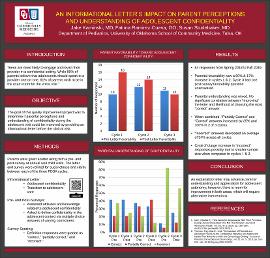| dc.description.abstract | BACKGROUND: Adolescence is a period of rapid emotional, behavioral, social, and physiological change in a child’s development. Evidence is conclusive that teens are more likely to engage and revisit their provider in a confidential setting. Parents frequently express hesitancy or opposition when asked to leave the room for the confidential portion of the visit. Studies have shown that while 89% of parents believe that adolescents should speak to a provider one-on-one, about 61% of parents wish to be in the exam room for the entire visit.
The goal of this quality improvement project was to determine if parental perceptions and understanding of confidentiality in the adolescent visit could be improved by providing an informational letter before the clinical visit.
METHODS: A letter that defined adolescent confidentiality was created and addressed to parents regarding their child(ren)’s transition to adolescent care. This letter, along with a pre- and post-letter survey, was given to parents at annual adolescent well-visits. The survey assessed attitudes and knowledge related to adolescent confidentiality. The knowledge section asked parents to define confidentiality in the adolescent context. The responses were graded as “correct,” “partially correct,” and “incorrect.” Three Plan-Do-Study-Act (PDSA) cycles were completed, revising the succinctness and clarity of the letter and the survey in between each cycle. This yielded a total of 64 responses between spring 2018 and fall 2019.
RESULTS: Across all PDSA cycles, the letter was reportedly easy to read. A 60% and 17% increase in parental favorability regarding adolescent confidentiality was seen in cycles 1 and 2. Letter clarity and succinctness were not correlated with parental perceptions, indicating little association between letter “improvements” and parental perceptions. Parental understanding of confidentiality was mixed. With each cycle, there was no significant correlation between reading the letter and likelihood of choosing the most “correct” answer. However, a 25% and 100% increase in combined “slightly correct” and “correct” answers in 2 of 3 cycles was seen. There was also an average 34% decrease of “incorrect” answers across all 3 cycles.
CONCLUSION: An explanatory letter may advance parents’ understanding and appreciation for adolescent autonomy; however, there is room for improvement in both areas, which will require alternative interventions. | en_US |

